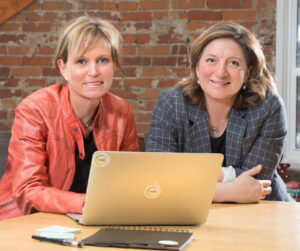The Essentials on Co-Design for Human & Health Services
By: Janeen Halliwell and Jennifer Friesen, People Minded Business
The term ‘co-design’ is surfacing in conversations, piquing people’s interests, and appearing on meeting agendas. What we are experiencing in our work is a strong desire by human and health services to learn more about the essentials – what is co-design, why do it, how to do it, and does it have staying power? This blog provides some answers.
What is Co-Design?
Let’s begin with what it is not. Co-design is not just a new way to say that stakeholders are involved in planning meetings and brainstorming sessions – co-design goes much deeper than this. Co-design is a way to authentically involve people who have a stake in service quality (people using services and their families, employees, board members, and other partners) in identifying challenges, opportunities AND solutions for the purpose of bettering their lives.
Co-design involves the use of a variety of tested methods – tools and techniques – from the creativity and design thinking disciplines. In our practice, we have and continue to adopt, adapt, develop, and customize “power tools” to garner true engagement by all involved. Participants in co-design sessions can sometimes be from one group, such as people using services, or they can include blended stakeholders. Composition is determined by the challenge or opportunity being explored.
What does Co-Design Look Like?
Regardless of who is in the group, co-design begins by exploring and going deep into ‘what matters most’ to the group in the context of a pressing challenge or potential opportunity. Ideas are then generated through activities that unleash divergent and convergent thinking – participants zoom out and zoom in to craft creative and doable solutions. Tools tap into participant’s experiences and senses – touch, sound, sight, and intuition. Importantly, co-design puts the power of designing solutions in the hands of the experts – the people who are experiencing the challenge or are invested in the opportunity, and who are most impacted by the result.
Why Co-Design?
The reasons for adopting co-design are many. The most compelling is that co-design provides an answer to a nagging problem that has faced human and health service providers for years: “How might we more meaningfully involve stakeholders (especially people using services, and their families) in planning, problem-solving, and decision-making?”
Specifically, co-design:
- Moves people’s involvement far beyond providing ‘input’ at planning meetings and participating in brainstorm sessions, to actively involving them as partners, creators, collaborators, and co-designers.
- Capitalizes on the experience and expertise of participants who understand themselves – their minds, bodies, behaviours, relationships, and expectations – better than anyone else.
- Facilitates people’s involvement in a variety of tried and tested engaging activities that produce solutions, outputs and outcomes that people jointly create and own.
- Involves designing novel solutions together, which garners engagement and minimizes resistance to change and newness.
The Future of Co-Design in Human & Health Services
We regularly look outside of the human and health sectors and into the private sector to see what’s brewing, becoming common place, or is now defunct, as most trends weave their way in, and out of, all sectors over time. Co-design is in the beginning stages of weaving its way in, and we believe it has strong legs and staying power. Why? For the reason that “design” has had a seat at the table of most industries and companies since their inception.
Historically, the ‘designer’ is a key member of any team that creates products or physical spaces. The parameters of design have gradually expanded over the years, alongside technology. As companies become more technologically advanced and on-line based, customers are invited in and encouraged to become more and more involved in designing the merchandise or experience they wish to purchase. Anyone can get online and personalize their next pair of sneakers or plan their perfect vacation get-away. It is no surprise that customers of non-profit services have also come to expect that their opinion matters, and that they become more involved in the process of designing their supports and services.
In the private sector, companies ensure design happens through the Chief Design Officer (CDO). Once declared by Fast Company as the ‘Job of the Future,’ the CDO has found its way onto many organizational charts and google searches. The appearance and prominence of the CDO underscores the level of importance placed on engaging the customer in a dynamic relationship, where together the company and customer create the desired product or experience. We anticipate that it won’t be long before the CDO position, or similar, finds its place on the leadership line of non-profit organizational charts. And it should.
We believe that NOW is an exciting time for human and health services, and even more so for the people who use them. With the growing interest and engagement in co-design, organizations can say and demonstrate that they are in fact, person-directed.

Janeen Halliwell and Jennifer Friesen of People Minded Business (PMB) have spent the last 30 years working to improve quality, advance new thinking, and drive innovation in human and health services. They are on a mission to introduce co-design and creative problem solving ‘power tools’ to people using human and health services worldwide, with the aim to elevate them as co-designers of their services. PMB has worked in Canada, USA, Australia, Mexico, and the United Kingdom.




